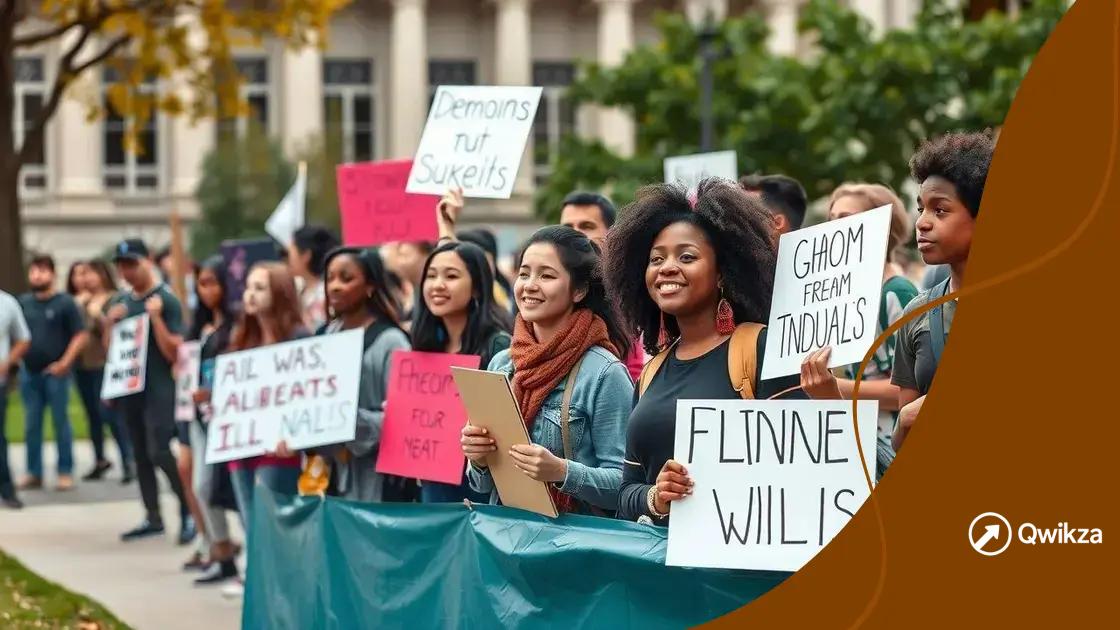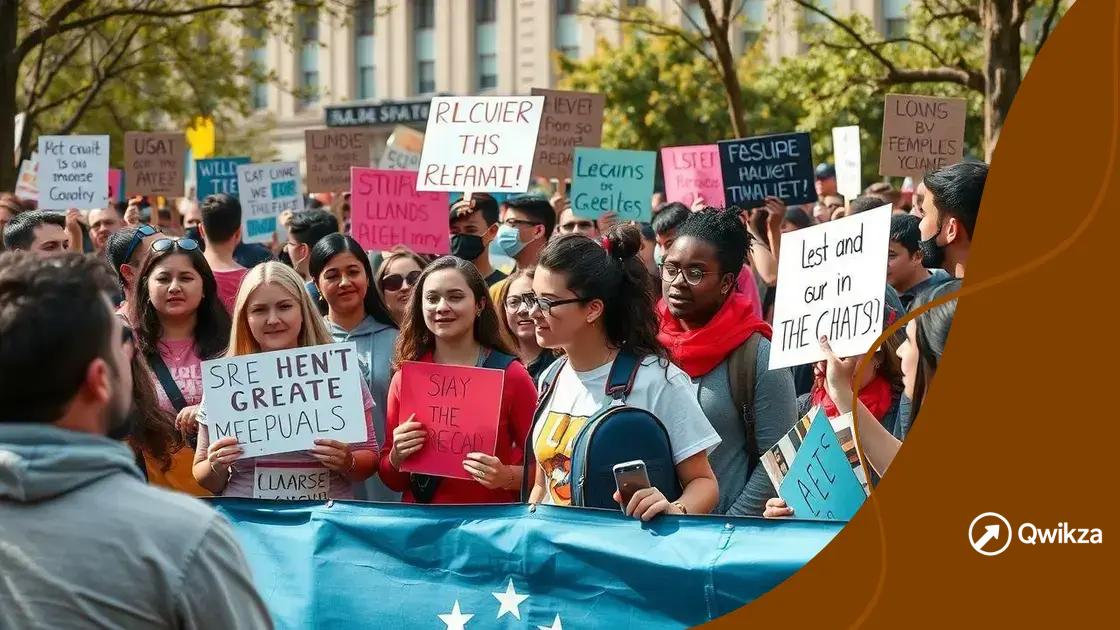Student protests over policy changes raise critical questions

Student protests over policy changes arise from financial burdens, insufficient mental health resources, and demands for inclusivity, prompting calls for improved communication and support from educational institutions.
Student protests over policy changes have become a powerful voice for change within educational institutions. As students stand up for their beliefs, the implications are profound, sparking conversations that could reshape their futures. What drives these movements, and what outcomes can we expect?
Understanding the reasons behind student protests
Understanding the reasons behind student protests is crucial for anyone wanting to grasp the dynamics of modern educational environments. Numerous factors can motivate these movements, often tied to broader societal issues.
Students are increasingly facing challenges that impact their academic experience. One of the primary catalysts for protests is perceived injustices within school policies. These can range from financial burdens, such as tuition hikes, to restrictions on free speech and the right to organize.
Key Motivations for Protests
As students express their concerns, several common themes emerge, reflecting their motivations:
- Financial concerns: Rising tuition and fees often make education inaccessible.
- Social justice: Many protests focus on issues around equity and representation.
- Educational policies: Changes in academic requirements can lead to unrest if students feel excluded.
- Mental health: Advocacy for better mental health resources is increasingly at the forefront.
Additionally, technology plays a role in amplifying voices. Social media enables students to organize quickly and share their messages widely. The immediacy of digital communication helps bring attention to their causes, attracting support from communities beyond their campuses.
Moreover, historical context is important. For many students, these protests are a continuation of long-standing efforts to challenge the status quo. Movements from previous decades serve as inspiration for today’s activism, driving students to demand change vigorously.
Understanding the reasons behind student protests requires recognizing the complex interplay of personal experiences, societal issues, and the evolving educational landscape. Each protest often tells a unique story, driven by passionate individuals seeking to create a lasting impact.
Impacts of policy changes on student life
Impacts of policy changes on student life can be profound, affecting various aspects of their academic experience. Understanding these impacts is essential to grasp how students respond and react to institutional changes.
When policies shift, students may feel a sense of disruption. For example, new tuition fees can strain budgets and force students to reconsider their education plans. Many must take on additional part-time jobs, leading to stress and affecting their academic performance.
Key Areas Affected by Policy Changes
Several critical areas of student life can be impacted by these shifts:
- Financial stability: Increasing costs create financial burdens that many students struggle to handle.
- Academic freedom: Restrictions on course offerings or curricula can limit students’ choices and stifle creativity.
- Mental health: Policy changes can lead to anxiety and uncertainty about the future.
- Support services: Cuts to counseling or academic support reduce available resources for struggling students.
Additionally, policy changes can affect campus culture. An environment that fosters engagement and inclusion may suffer if students feel disenfranchised. They may organize protests to voice their dissatisfaction, highlighting their need for change.
The transition period following policy changes can also lead to confusion and misinformation among students. Clear communication from institutions is vital to alleviate concerns and reassure students that their needs are being prioritized.
Ultimately, understanding the impacts of policy changes on student life requires a look into how deeply intertwined these policies are with students’ daily experiences and futures. Students not only adapt but also advocate for their rights, demonstrating resilience and determination.
Key moments in recent protests

Key moments in recent protests reveal the evolution of student activism and highlight significant events that shaped these movements. Understanding these moments can provide insight into the motivations and goals of today’s students.
One of the pivotal events occurred in response to funding cuts for universities. Students across the country organized rallies on campuses, demanding better resources and support from their institutions. This sparked solidarity among different schools, showcasing how interconnected student issues are.
Major Events That Defined the Protests
Several key events stand out:
- National Marches: Large-scale gatherings held in major cities brought together thousands of students, emphasizing the urgency of their demands.
- Online Campaigns: Social media played a crucial role in mobilizing support, with hashtags trending globally and uniting students’ voices.
- Campus Walkouts: Many students participated in walkouts to express their discontent with specific policies, making their voices heard directly.
- Collaborations with Community Groups: Students joined forces with local organizations to drive home the message of their protests, increasing outreach and impact.
Additionally, emotional speeches from student leaders often resonate deeply with peers. These speeches articulate personal experiences and convey the pressing need for change. Moments of unity, where students join together in chants and songs, foster a sense of community spirit and strengthen the movement.
Furthermore, media coverage plays a vital role in amplifying protest voices. Coverage can bring attention to the issues at hand and put pressure on decision-makers to respond to students’ needs. Each protest provides an opportunity for discussion and reflection on the challenges facing students today.
Overall, these key moments in recent protests reflect a powerful blend of passion, purpose, and shared experiences among students. The ongoing dialogues surrounding these issues highlight the continued push for progress in educational policies.
Voices from the front lines: students’ perspectives
Voices from the front lines: students’ perspectives shed light on the urgency and passion driving recent protests. These firsthand accounts offer a glimpse into the realities students face while navigating their academic experiences.
Many students express feelings of frustration when addressing major issues like affordable education and access to resources. Their personal stories often highlight the struggles they encounter daily. For instance, one student shared how the rising cost of textbooks forced them to choose between buying necessary materials and paying for food.
Personal Stories that Matter
Several themes emerge from students’ perspectives:
- Financial strain: Many students struggle to balance tuition fees, living expenses, and unpaid internships.
- Emotional toll: The pressure to succeed amidst changes can lead to anxiety and mental health challenges.
- Desire for inclusion: Students often call for a more inclusive environment where every voice matters.
- Hope for change: Despite challenges, students remain hopeful and vocal about their demands for better policies.
In interviews, students frequently describe their participation in protests as eye-opening and empowering. They enjoy sharing their stories, feeling a strong sense of community with fellow activists. Many remarked that being part of a movement allowed them to connect with others who face similar struggles.
Moreover, students are increasingly using social media to amplify their messages. Platforms like Twitter and Instagram have enabled them to reach broader audiences and gain support beyond their campuses. The immediacy of these tools helps to draw attention to pressing issues, driving essential conversations forward.
Understanding these student perspectives not only highlights the realities of their situations but also fosters empathy among peers and administrators alike. These voices are vital in shaping future policies and creating a more supportive educational environment.
Potential solutions and next steps for institutions
Potential solutions and next steps for institutions are vital for fostering a supportive environment for students. Addressing the ongoing issues raised during protests requires immediate action and careful planning.
One effective solution is enhancing communication between students and administrators. Regular town hall meetings can provide a platform for open discussions, allowing students to voice their concerns directly. By establishing such channels, institutions show they value student input and are willing to make adjustments based on feedback.
Key Areas for Improvement
Several critical strategies can be implemented to support students better:
- Financial aid reform: Reviewing and improving financial aid processes can ease the burden on students, ensuring they can access necessary funding without unnecessary obstacles.
- Increased mental health resources: Expanding counseling services and workshops can help support students’ well-being, addressing the emotional challenges they face.
- Inclusive policies: Institutions should actively work to create policies that promote diversity and inclusion, ensuring all voices are heard and respected.
- Career development programs: Offering internships and mentorship opportunities can prepare students for the workforce, alleviating financial stress related to job hunting.
Moreover, collaborating with external organizations can bring additional resources to the table. Partnerships with local businesses and non-profits can create more opportunities for students, including internships and volunteer work.
Continuous evaluation of implemented solutions is crucial. Institutions need to regularly assess their effectiveness and make adjustments based on student feedback and changing needs. By developing a culture of adaptability, educational institutions can better respond to the challenges they face.
Ultimately, taking these proactive steps not only addresses the concerns raised by students but also fosters a more supportive and constructive environment for everyone involved.
\n
| 🌟 Key Focus Areas | 🔍 Description |
|---|---|
| Financial Aid | Improve access to support for students. |
| Mental Health | Expand counseling services and wellness programs. |
| Inclusivity | Foster a culture of respect and cooperation. |
| Collaboration | Encourage dialogue between students and faculty. |
| Career Programs | Offer internship and mentorship opportunities. |
\n
\n
FAQ – Frequently Asked Questions about Student Protests and Solutions
What are the main reasons behind student protests?
Students often protest due to financial burdens, lack of mental health resources, and demands for inclusive policies.
How can institutions support students better?
Institutions can improve support by enhancing financial aid, expanding mental health services, and fostering open communication.
What role does social media play in student protests?
Social media helps students organize and share their messages widely, amplifying their voices and drawing attention to their causes.
Why is collaboration between students and faculty important?
Collaboration ensures that students’ concerns are addressed, leading to policies that genuinely reflect their needs and experiences.
